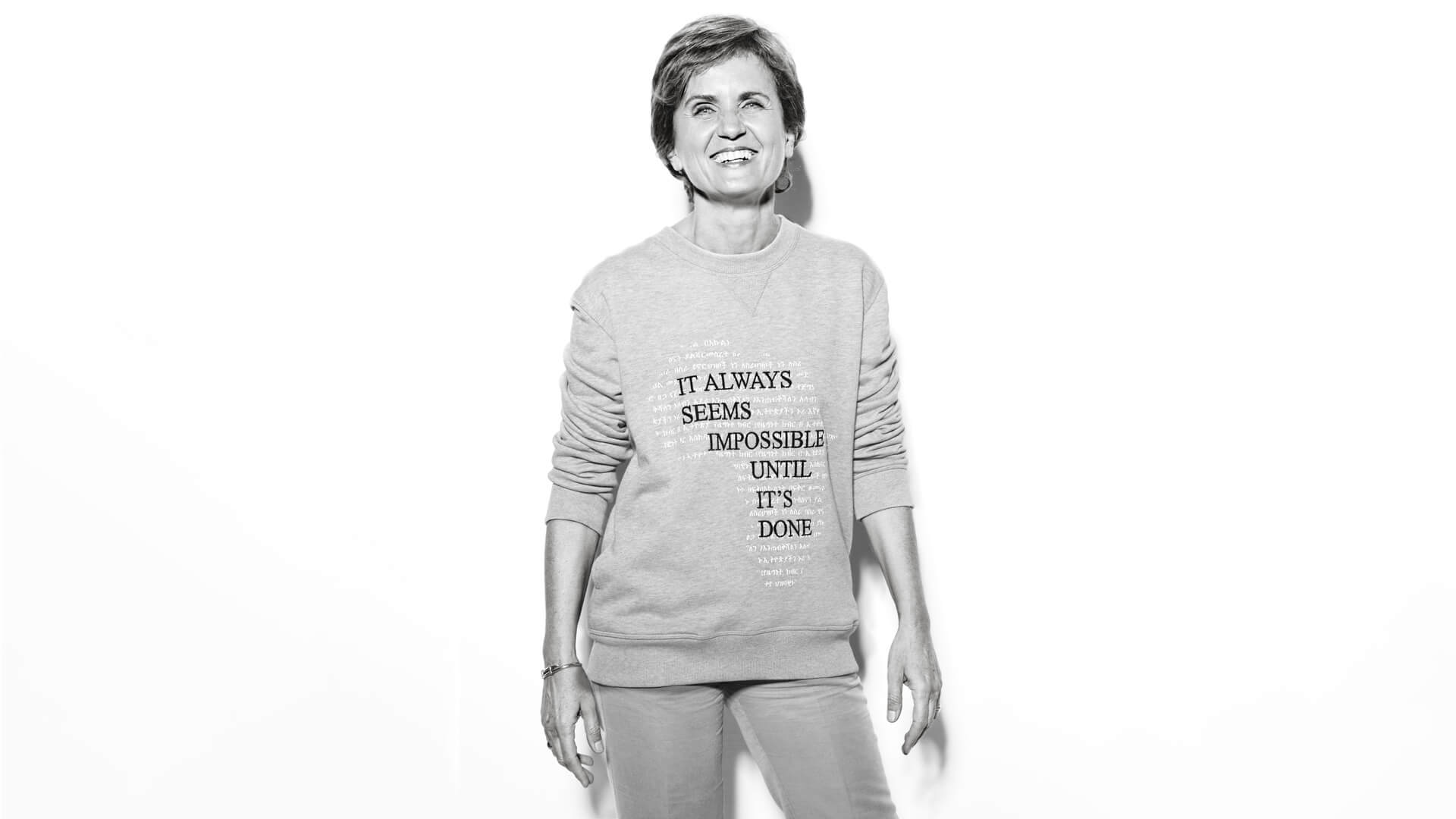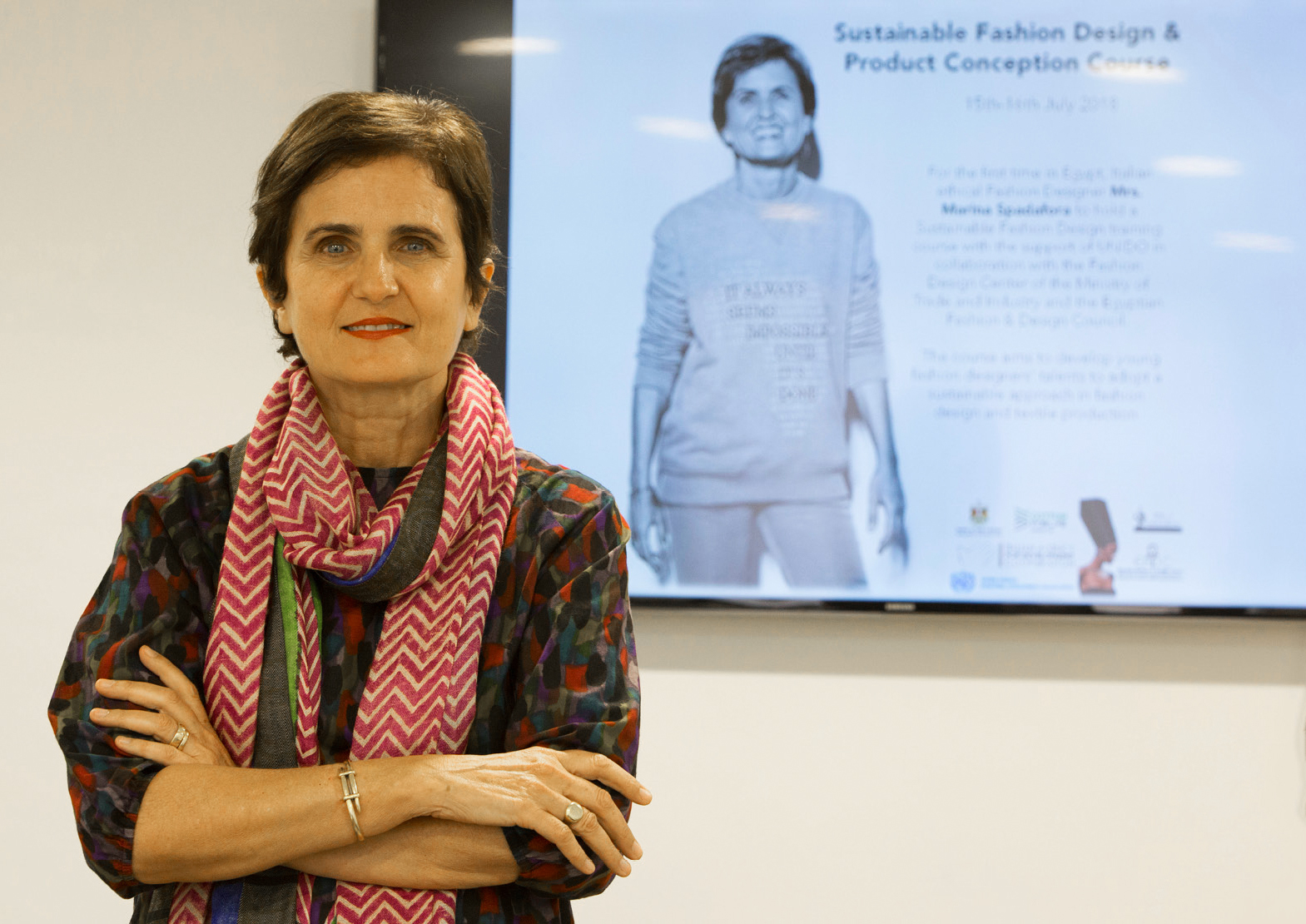Change begins with revolution.
Revolution begins with indignation.
Marina Spadafora reminds us of this mantra every day: coordinator of Fashion Revolution Italy, ethical fashion ambassador, Senior Design Consultant, writer and teacher, with her actions and words she shows us how much it is a responsibility of all of us to take care of our planet and other people. A topic, that of responsibility, which is intertwined with that of sustainability as two threads of a precious texture, which involves anyone, new and old generations, to scream to be heard by those who hold power and to allow in this way the revolution to achieve its goal.
To make the world a better place, ethical choice after ethical choice, political move after political choice, and so on. Because things always seem impossible until they are done: on the occasion of the Venice Fashion Week, to which Marina took part as a speaker at Sustainable Fashion Day, we chatted with her about the importance of being indignant and taking the situation in hand to make sustainability “cool“, current and essential. Together. Right now.
This Venice Fashion Week has once again reminded us that, besides talking about sustainability, we should also discuss the theme of responsibility. In your opinion, in which way these two concepts are synonyms?
I think they’re synonyms (and very close synonyms) because nowadays the word sustainability is on everyone’s lips and sometimes even a bit misused. Therefore we, who’ve been in this field for many years, perhaps prefer using the word “responsibility” because, actually, if you do something responsibly, then it’s automatically also sustainable. So, the two words are interchangeable, I believe, and the word “responsibility” is slightly less abused and we like it more.
Change is possible through individual and public effort and must be supported by correct communication. Over these years of debates that have (luckily) been more and more persistent about sustainability in fashion, is there something that positively struck you? And something you think there’s still a lack of?
I think that we still don’t speak enough about it, this topic should be ever more present on “traditional” media, like the TV news, we should be talking about it every day, which is why Greta Thunberg started her campaign in the first place, in fact, she said, “here the world is going down the drain and no one ever talks about it”. So, I believe there’s a lack of a lot of things, especially in official communication in Italy, for example, that of TV networks like Rai, or newspapers like Corriere della Sera or Repubblica, that is institutional media.
When they asked me to be Fashion Revolution’s National Coordinator, back when it was born in 2014, what struck me about this movement was its way of communicating. Orsola de Castro, the Creative Director, found a very pop and fun key to face a subject that wasn’t fun at all. However, by making it all so colorful, with strong, graffiti-style writings, and so on, she managed to attract young people, and that for me is an example of successful communication. Fashion Revolution has managed to convey a strong message, yet with a joyful and lighthearted spirit. Sometimes, when you talk about these topics, you risk making it really heavy because I realize that when I talk to my students, I always have to make sure to counterbalance by saying, “anyway, we can do this”, “however, there’s the possibility of moments where things will be better”; so, it’s very important to be proactive and also attractive.
A couple of years ago, we were invited by Orsola to attend London’s Fashion Revolution Week, and we took part in lots of activities like illustration workshops, talks, and much more – they would all discuss sustainability in a precisely attractive way…
Exactly because sustainability has a “bad name”. When everything started back in the ‘70s, it was really about hippies with jute sacks and nettle socks and Birkenstocks, when they weren’t fashionable [laughs]. From this point of view, and if you think that in the beginning, sustainable fabrics were bad-looking, rough, and unattractive, you understand how that has felt uncomfortable for us for many years. To explain, now, to young people that sustainability is also cool, attractive, and beautiful is not an obvious thing to accomplish because there still is that kind of collective imagery.

We turn to young people especially when we talk about sustainability in fashion and beyond, and it’s a topic to which they’ve really been paying attention – just think about their renewed interest in topics like vintage and upcycling. This issue, anyways, concerns all of us no matter how old we are, but what is it that changes, in your opinion, in the intergenerational dialogue on this topic?
In my opinion, we need young people to understand that responsibility, in whichever thing we do, is achievable, it’s implementable: it’s simply about being present in the present moment, in doing what we do and doing it with awareness. We need to let them know, I think, without blaming them, we shouldn’t inflict on young people this sense of heaviness, also because the fault is ours, of the previous generations, so there’s no point for us to act like the cool kids [laughs]. We’ve provoked a disaster. Now, the conscientious among us are trying to “fix it”, but we need to call young people and involve them in a way, again, that is not punishing, nor sensationalized, in a “The Day After Tomorrow”-style, we need to say: “Guys, if we join forces and each of us plays their small part, we can make it. Let’s do this, we don’t have much time, but let’s do it”.
What’s really important to understand is that it’s more than okay to get involved in small, everyday actions that pull us closer to each other, but it’s time to be seriously committed now. As the oceanographer was saying in the talk, before, everything we do is political: every purchase we make is not only an economical action, but it absolutely is political, too, because if I buy something from a brand that has bad behavior, I’m actually financing that brand with my money. If you don’t want to be associated with someone who exploits children in factories, who pollutes, and so on and so forth, just abstain, don’t buy from it.
Therefore, information, education, but engaging, an education that embraces, that says, “we can do it together”, getting off the “teacher’s desk” and getting in touch, with a very emphasized human factor.
It’s officially April, which means Earth Day and the anniversary of the Rana Plaza catastrophe, from which the Fashion Revolution moment originated, of which you are the coordinator for Italy. This year marks 10 years from the disaster: how would you describe your revolution journey so far?
My journey is in constant evolution. I started caring about sustainability more or less in 2006 and since then I’ve been consistent, I’ve been doing lots of projects, lots of education, lots of everything. From an industrial point of view, as well, after the Rana Plaza tragedy, for example, the Accord on Fire and Building Safety in Bangladesh was signed, thanks to which many factories in Bangladesh have been secured, so it’s a positive thing. What’s negative about it is that it’s an agreement that needs to be renewed every year, so every year you need to chase all brands that produce their items in Bangladesh and beg them to sign it again, this is the big rip-off. Anyways, at least it exists and this means we’re evolving, maybe, unfortunately, not fast enough, but things are moving.

Focusing on Italy, how can our country promote our traditional fashion, knowledge, and how-to heritage in a sustainable and ethical way?
In my opinion, we have an incredible textile heritage that has been thrown away a little bit when we started uncontrolled offshore outsourcing without the government imposing any kind of rules for it. So, you’re a company and you wish to produce 40-50% of your items abroad? Fine, but you must make the rest of it in Italy – there you go, we need a strategy.
Furthermore, our ruling class, government after government, can’t see that the textile industry is a strategic industry for this country. I was invited to talk to the Senate when a decision had to be made on how to invest our NRRP, where I gave my presentation and was a bit harsh with them, underlining how the textile industry is in second position in Italy for job creation and many more things – but shall we give it a bit more help and respect?
It takes more support on an institutional level, more recognition, and greater seriousness from our politicians for this industry’s role to be recognized. And also more rules, enough with all this wilderness, the Made in Italy needs to be changed, you can’t say it’s Made in Italy only because you’ve sewn a button last-second in Italy but as for the rest of it, you’ve made it somewhere else…
What’s the book on your nightstand now? And by the way, are you planning to write a new one yourself?
Now, I’m reading a book by Naomi Klein called “This Changes Everything”: it talks about the climate crisis, and the author explains how this crisis that concerns all human beings, a bit like Covid, it’s something that really involves everyone. She says that if we’re smart enough to handle this on a grassroots level, we can really change everything because there have been other claims in history where the citizens’ indignation resulted in the abolition of slavery, the concession of the voting right to women, the abolition of racial segregation in the United States, Apartheid in South Africa.
We need to be outraged, seriously, and so make these things happen, it’s vital. This means more activism, more “putting our face and getting our hands dirty”.
Thanks to Venice Fashion Week and Venezia da Vivere.
If you are an EU citizen, sign the Good Clothes, Fair Pay campaign, which demands living wage legislation across the garment, textile and footwear sector.



![Interview With Norbert Stumpfl [Executive Design Director of Brioni]: The Humanity of Creation](https://www.theitalianreve.com/wp-content/uploads/2023/06/EP_EDP_Essentiel_1-300x169.jpg)

